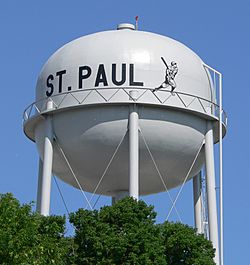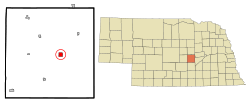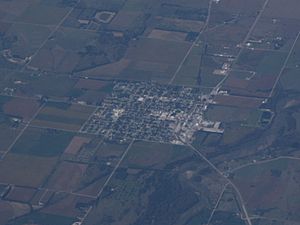St. Paul, Nebraska facts for kids
Quick facts for kids
St. Paul, Nebraska
|
|
|---|---|

St. Paul water tower, with image of baseball player Grover Cleveland Alexander
|
|

Location of St. Paul, Nebraska
|
|
| Country | United States |
| State | Nebraska |
| County | Howard |
| Area | |
| • Total | 1.03 sq mi (2.62 km2) |
| • Land | 1.03 sq mi (2.62 km2) |
| • Water | 0.00 sq mi (0.00 km2) |
| Elevation | 1,814 ft (553 m) |
| Population
(2010)
|
|
| • Total | 2,290 |
| • Estimate
(2019)
|
2,333 |
| • Density | 2,265.05/sq mi (890.46/km2) |
| Time zone | UTC-6 (Central (CST)) |
| • Summer (DST) | UTC-5 (CDT) |
| Zip Code |
68873
|
| FIPS code | 31-43265 |
| GNIS feature ID | 0833046 |
| Website | http://www.stpaulnebraska.com/ |
St. Paul is a city in and the county seat of Howard County, Nebraska, United States. The population was 2,290 at the 2010 census.
St. Paul is part of the Grand Island, Nebraska Micropolitan Statistical Area.
Geography
St. Paul is located at 41°12′49″N 98°27′36″W / 41.21361°N 98.46000°W (41.213709, -98.459881).
According to the United States Census Bureau, the city has a total area of 1.11 square miles (2.87 km2), all land.
Climate
| Climate data for St. Paul, Nebraska (1991–2020 normals, extremes 1899–present) | |||||||||||||
|---|---|---|---|---|---|---|---|---|---|---|---|---|---|
| Month | Jan | Feb | Mar | Apr | May | Jun | Jul | Aug | Sep | Oct | Nov | Dec | Year |
| Record high °F (°C) | 74 (23) |
79 (26) |
92 (33) |
98 (37) |
106 (41) |
110 (43) |
115 (46) |
111 (44) |
108 (42) |
97 (36) |
85 (29) |
81 (27) |
115 (46) |
| Average high °F (°C) | 35.4 (1.9) |
40.9 (4.9) |
54.0 (12.2) |
64.9 (18.3) |
73.9 (23.3) |
84.3 (29.1) |
88.8 (31.6) |
86.6 (30.3) |
80.0 (26.7) |
66.5 (19.2) |
50.1 (10.1) |
38.0 (3.3) |
63.6 (17.6) |
| Daily mean °F (°C) | 24.9 (−3.9) |
29.4 (−1.4) |
41.1 (5.1) |
51.6 (10.9) |
61.9 (16.6) |
72.2 (22.3) |
76.9 (24.9) |
74.8 (23.8) |
66.8 (19.3) |
53.5 (11.9) |
38.9 (3.8) |
28.1 (−2.2) |
51.7 (10.9) |
| Average low °F (°C) | 14.3 (−9.8) |
18.0 (−7.8) |
28.1 (−2.2) |
38.2 (3.4) |
49.9 (9.9) |
60.0 (15.6) |
65.0 (18.3) |
63.0 (17.2) |
53.6 (12.0) |
40.4 (4.7) |
27.7 (−2.4) |
18.2 (−7.7) |
39.7 (4.3) |
| Record low °F (°C) | −33 (−36) |
−32 (−36) |
−17 (−27) |
−2 (−19) |
21 (−6) |
34 (1) |
42 (6) |
36 (2) |
22 (−6) |
5 (−15) |
−11 (−24) |
−29 (−34) |
−33 (−36) |
| Average precipitation inches (mm) | 0.55 (14) |
0.70 (18) |
1.57 (40) |
2.73 (69) |
4.47 (114) |
4.01 (102) |
3.47 (88) |
3.47 (88) |
2.13 (54) |
2.18 (55) |
1.18 (30) |
0.86 (22) |
27.32 (694) |
| Average snowfall inches (cm) | 4.7 (12) |
6.2 (16) |
3.0 (7.6) |
1.8 (4.6) |
0.0 (0.0) |
0.0 (0.0) |
0.0 (0.0) |
0.0 (0.0) |
0.0 (0.0) |
0.4 (1.0) |
2.2 (5.6) |
4.1 (10) |
22.4 (57) |
| Average precipitation days (≥ 0.01 in) | 3.8 | 4.8 | 6.2 | 8.6 | 10.9 | 9.6 | 8.8 | 8.2 | 6.3 | 6.7 | 4.2 | 4.0 | 82.1 |
| Average snowy days (≥ 0.1 in) | 2.6 | 3.1 | 1.3 | 0.8 | 0.0 | 0.0 | 0.0 | 0.0 | 0.0 | 0.2 | 1.3 | 2.6 | 11.9 |
| Source: NOAA | |||||||||||||
Demographics
| Historical population | |||
|---|---|---|---|
| Census | Pop. | %± | |
| 1880 | 482 | — | |
| 1890 | 1,263 | 162.0% | |
| 1900 | 1,475 | 16.8% | |
| 1910 | 1,336 | −9.4% | |
| 1920 | 1,615 | 20.9% | |
| 1930 | 1,621 | 0.4% | |
| 1940 | 1,571 | −3.1% | |
| 1950 | 1,676 | 6.7% | |
| 1960 | 1,714 | 2.3% | |
| 1970 | 2,026 | 18.2% | |
| 1980 | 2,094 | 3.4% | |
| 1990 | 2,009 | −4.1% | |
| 2000 | 2,218 | 10.4% | |
| 2010 | 2,290 | 3.2% | |
| 2019 (est.) | 2,333 | 1.9% | |
| U.S. Decennial Census 2012 Estimate |
|||
2010 census
As of the census of 2010, there were 2,290 people, 989 households, and 590 families residing in the city. The population density was 2,063.1 inhabitants per square mile (796.6/km2). There were 1,093 housing units at an average density of 984.7 per square mile (380.2/km2). The racial makeup of the city was 98.1% White, 0.3% African American, 0.1% Native American, 0.1% Asian, and 1.3% from two or more races. Hispanic or Latino of any race were 1.4% of the population.
There were 989 households, of which 29.4% had children under the age of 18 living with them, 47.3% were married couples living together, 9.2% had a female householder with no husband present, 3.1% had a male householder with no wife present, and 40.3% were non-families. 36.1% of all households were made up of individuals, and 21.8% had someone living alone who was 65 years of age or older. The average household size was 2.28 and the average family size was 3.00.
The median age in the city was 40.3 years. 26% of residents were under the age of 18; 6% were between the ages of 18 and 24; 22.9% were from 25 to 44; 24% were from 45 to 64; and 21.1% were 65 years of age or older. The gender makeup of the city was 48.3% male and 51.7% female.
History
St. Paul was founded by two young surveyors, James N. and Nicholas J. Paul, who had been surveying in Nebraska and the surrounding areas as the land opened to settlers. Struck by the beauty and the prospects of the Loup valley, they took out homesteads, successfully petitioned the state legislature to form a new county to be known as Howard County, and laid out the townsite. They brought the first settlers to the county in March 1871 and established the seat of government in St. Paul. Stillman Hazeltine put up the first building for a general store and town hall in the summer of 1871. That first building burned a few years later and the brick building which replaced it is still in use with his name and date 1871 on the front.
When the town was to be named, a committee collected the suggested names in a hat and the name Athens was drawn. Since Athens already existed in the state, Nebraska Senator Phineas W. Hitchcock suggested the name St. Paul in honor of the Paul brothers who founded it. It officially became the county seat by vote in 1874 and was incorporated in 1881. The first mayor was E.F. Clapp.
During its first twenty years, Howard County was a typical western frontier with covered wagons, cowboys, huge cattle herds, rowdy railroad construction gangs, and Army detachments stationed within its borders. As settlers and the railroad extended north and west, the town of St. Paul served as an important trade center and quickly grew to a population of 2,000 residents. From 1882 until 1917, St. Paul was the home of Frank Iams, the nation's largest importer of European draft horses. Three-star General C.S. Irvine set record-shattering, long-distance flights in a B-29 shortly after World War II. Herbert Paul was Adjutant General of the Nebraska National Guard for 19 years.
St. Paul had a broom factory, canning factory, brick factory, cigar factory, two flour mills, hatchery and more. Through the years innovation like the first self-rising flour was developed at one of the flour mills. The first chicken hatchery in Nebraska started in Cushing in 1901, moved to St. Paul in 1922, and operated until 1956. Pirus, a cure for many kidney and liver ailments, was invented in St. Paul. Dorothy Lynch invented her famous salad dressing in St. Paul, which is now sold nationally.
Grover Cleveland Alexander, who was inducted into the National Baseball Hall of Fame, was born on a farm in the area and retired to St. Paul at the end of his sports career. The American Legion baseball field was dedicated on June 15, 1971, and named after Alexander. Each year St. Paul honors Alexander with the celebration of Grover Cleveland Alexander (GCA) Days, the weekend following the 4th of July.
Notable people
- Jon Lynn Christensen, Member of the U.S. House of Representatives from Nebraska's 2nd district (January 3, 1995 – January 3, 1999)
- Dorothy Lynch, creator of Dorothy Lynch salad dressing
- Vickie D. McDonald, Nebraska legislator
- Jean Potts, Author of Go, Lovely Rose, which won the Mystery Writers of America's Best First Novel Edgar Award for 1955
See also
 In Spanish: St. Paul (Nebraska) para niños
In Spanish: St. Paul (Nebraska) para niños


